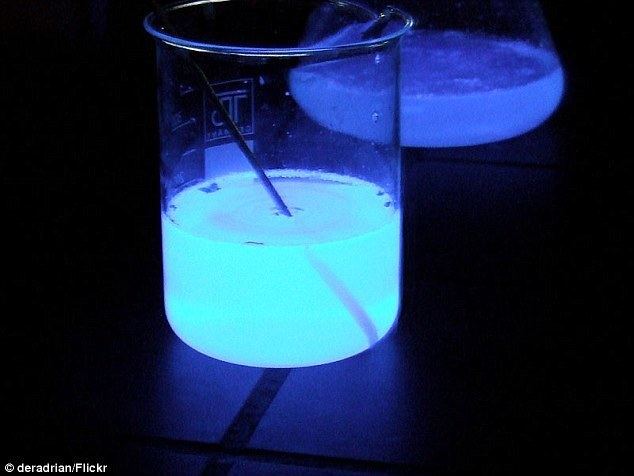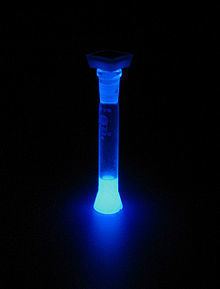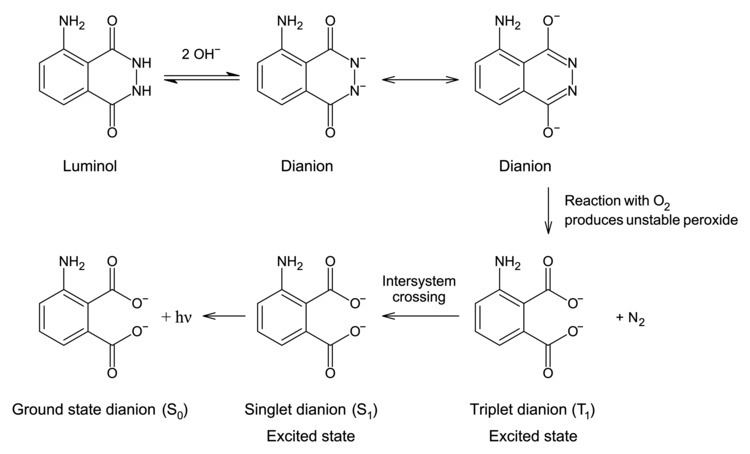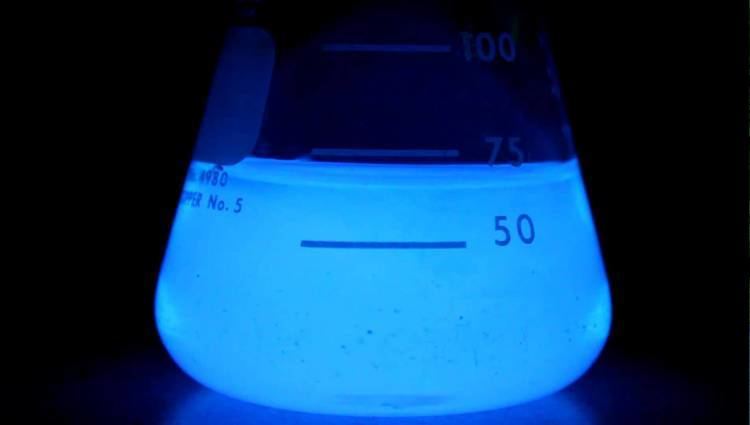Formula C8H7N3O2 | Molar mass 177.16 g/mol | |
 | ||
Similar Benzidine, Phenolphthalein, Ninhydrin | ||
Liquid light chemical reaction with luminol
Luminol (C8H7N3O2) is a chemical that exhibits chemiluminescence, with a blue glow, when mixed with an appropriate oxidizing agent. Luminol is a white-to-pale-yellow crystalline solid that is soluble in most polar organic solvents, but insoluble in water.
Contents
- Liquid light chemical reaction with luminol
- Wpi touch tomorrow luminol experiment
- Synthesis
- Chemiluminescence
- History
- Theory
- Drawbacks
- Commercial Formulations
- Related molecules
- References

Forensic investigators use luminol to detect trace amounts of blood at crime scenes, as it reacts with the iron in haemoglobin. Biologists use it in cellular assays to detect copper, iron, and cyanides, as well as specific proteins by western blot.

When luminol is sprayed evenly across an area, trace amounts of an activating oxidant make the luminol emit a blue glow that can be seen in a darkened room. The glow only lasts about 30 seconds, but investigators can document the effect with a long-exposure photograph. Crime scene investigators must apply it evenly to avoid misleading results, as blood traces appear more concentrated in areas that receive more spray. The intensity of the glow does not indicate the amount of blood or other activator present, but only shows the distribution of trace amounts in the area.

Wpi touch tomorrow luminol experiment
Synthesis

Luminol may be synthesized by reverse-phosphorescence, two-step process. It begins from 3-nitrophthalic acid. First, hydrazine (N2H4) is heated with the 3-nitrophthalic acid in a high-boiling solvent such as triethylene glycol. An acyl substitution condensation reaction occurs, with loss of water, forming 3-nitrophthalhydrazide. Reduction of the nitro group to an amino group with sodium dithionite (Na2S2O4), via a transient hydroxylamine intermediate, produces luminol.
The compound was first synthesized in Germany in 1902, but was not named "luminol" until 1934.
Chemiluminescence

To exhibit its luminescence, the luminol must be activated with an oxidant. Usually, a solution containing hydrogen peroxide (H2O2) and hydroxide ions in water is the activator. In the presence of a catalyst such as an iron or periodate compound, the hydrogen peroxide decomposes to form oxygen and water:
2 H2O2 → O2 + 2 H2OH2O2 + KIO4 → KIO3 + O2 + H2OLaboratory settings often use potassium ferricyanide or potassium periodate for the catalyst. In the forensic detection of blood, the catalyst is the iron present in haemoglobin. Enzymes in a variety of biological systems may also catalyse the decomposition of hydrogen peroxide.
Luminol reacts with the hydroxide ion, forming a dianion. The oxygen produced from the hydrogen peroxide then reacts with the luminol dianion. The product of this reaction—an unstable organic peroxide—is made by the loss of a nitrogen molecule, the change of electrons from excited state to ground state, and the emission of energy as a photon. This emission produces the blue glow.
History
In 1928, German chemist H. O. Albrecht found that blood, among other substances, enhanced the luminescence of luminol in an alkaline solution of hydrogen peroxide. In 1936, Karl Gleu and Karl Pfannstiel confirmed this enhancement in the presence of haematin, a component of blood. In 1937, German forensic scientist Walter Specht made extensive studies of luminol's application to the detection of blood at crime scenes. In 1939, San Francisco pathologists Frederick Proescher and A. M. Moody made three important observations about luminol: (1) although the test is presumptive, large areas of suspected material can be examined rapidly; (2) dried and decomposed blood gave a stronger and more lasting reaction than fresh blood; and (3) if the luminescence disappears, it may be reproduced by the application of a fresh luminol-hydrogen peroxide solution; dried bloodstains may thus be made luminescent repeatedly.
Theory
Crime scene investigators use luminol to find traces of blood, even if someone has cleaned or removed it. The investigator sprays a solution of luminol and the oxidant. The iron in blood catalyses the luminescence. The amount of catalyst necessary to cause the reaction is very small relative to the amount of luminol, allowing detection of even trace amounts of blood. The blue glow lasts for about 30 seconds per application. Detecting the glow requires a fairly dark room. Any glow detected may be documented by a long-exposure photograph.
Drawbacks
Luminol has drawbacks that can limit its use in a crime scene investigation:
Commercial Formulations
Since its introduction in the early 2000s, a luminol-based proprietary composition trademarked Bluestar is being increasingly used instead of generic formulations. Bluestar luminescence is brighter and lasts longer than carbonate/perborate luminol compositions, so it is possible to use it when complete darkness cannot be achieved. Variations in color, intensity and duration of luminescence with different trace catalysts provide for fewer false positives.
Related molecules
C8H7N3O2 — MW: 177.16
λabs (in 0.1 N NaOH) λmax 1 : 347 nm & λmax 2 : 300 nm; EC (at λmax 1): 7650 L/mol × cm
λabs / λem (MeOH): 355/413 nm
C8H6N3O2Na — MW: 199.12
C8H6N3O2Na·H2O — MW: 217.16
C8H7N3O2 · HCl — MW: 213.62
C8H7N3O2 – MW: 117.16 (Xi)
C8H7N3O2 · H2O — MW: 195.15
